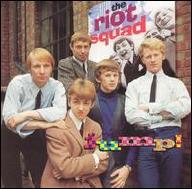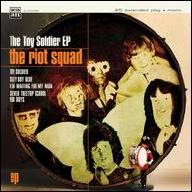Their story began in 1964 when producer Larry Page decided to put together a group whose sound would be a more pop-focused brand of British Invasion-style rock from that of his one big success of the time, the Kinks. The resulting lineup included Graham Bonney (aka Graham Bradley) (guitar/vocals), Ron Ryan (guitar/vocals), Mark Stevens (organ), Mike Martin (bass), Bob Evans (saxophone), and John Mitchell (later better known as Mitch Mitchell) (drums). They were all young, from 17 to 22, but had surprisingly extensive experience as session musicians, and each was proficient on more than one instrument, which allowed for the potential for Page to use them in a multitude of modes and styles, and musical capacities. Page was going to call them simply "Riot," but Evans proposed and he accepted the alternative of Riot Squad. The irony was that once he had them assembled and they began working together, they plunged in exactly the opposite direction from what Page had intended -- the sextet discovered that they shared a natural affinity for and ability with the bluesier, more RB-inflected side of British rock roll.
They roared into 1965 with a debut single, Anytime b/w Jump, a double-sided soul shouter that got great reviews and showed this band to have some potential to go head to head with the Rolling Stones or the Animals, forget the Kinks. A follow-up single eight weeks later, I Wanna Talk About My Baby b/w Gonna Make You Mine, got similar high praise and both earned considerable airplay without actually selling a lot of copies -- this seems amazing today, as the A-side was a superb piece of smooth blue-eyed soul, closer to Georgie Fame than to the Animals. But by then the group was starting to build a reputation as a live act and their shows were pulling serious crowds. Things started to go wrong just as they were looking up -- the band's hopes were hinged on a tour with the Kinks and the Yardbirds, but when the Kinks had to pull out, owing to an injury to Ray Davies, everything else fell apart, as the Yardbirds' commitment became shaky as well. What had seemed a golden opportunity now became a non-starter. A third single, Nevertheless b/w Not a Great Talker, was also well reviewed and seemed to portend great possibilities. But amid these efforts to break through in the year 1965, there were already internal stresses threatening the group -- Martin was the first to exit, followed by Ryan, who'd sung lead on the first two singles; and then Bonney, who'd sung lead on Nevertheless, decided to opt out in favor of a solo career.
That seemed to mark the end for the group as a coherent, cohesive unit, and before that point even Larry Page had moved on to other projects and opportunities. Mitch Mitchell jumped to Georgie Fame's band the Blue Flames, and that seemed to be all for the band. But then saxman Bob Evans, recognizing that the group had a stage reputation and also that those positive reviews of the first records comprised something to build on, however small, decided to try and salvage something from the previous year of work. He assembled what was essentially the Riot Squad (Mark II) by recruiting a promising London-based outfit called the Chevrons. The new lineup, with Evans on sax, included Keith Nero Gladman (vocals), Terry Clifford (guitar), Butch Davis (piano), Rodger Crisp (bass), and Del Roll (drums) -- they already had a soulful American sound similar to Riot Squad, and he was very convincing in his pitch to the band backstage at a gig in Edmonton. Next came a serious brush with greatness when they managed to get a recording contract with no less a figure than producer Joe Meek, who did the new Riot Squad a huge service on their debut single, Cry Cry Cry b/w How It Is Done. The A-side was a little poppish, and featured a more flamboyant organ part (probably played by a pre-Deep Purple Jon Lord) than their previous records would have displayed, but it also had enough of a soul edge in some of the singing to be valid as one of their releases, and it should have been a contender for airplay in the pop-focused rock roll world of 1965; the B-side was a cool shouter that showed off everyone's instrumental prowess and was catchy in its own right, as well as a little harder. The A-side actually made the lower reaches of the U.K. sales charts, but it was the B-side that proved an enduring classic of its genre, its punchy, driving beat and break memorable in its own right.
They went to the well with Meek again on I Take It That We're Through b/w Working Man, which once more got great reviews, but once again failed to chart. In the meantime, between their own gigs and recording sessions, Meek kept them busy backing various vocal artists of his, including Glenda Collins, and they were happy to go along, partly owing to the respect they felt for him as a producer. By this time, it was becoming clear, however, that whatever his abilities as a producer, Meek lacked the clout or the resources to promote the group's records properly, in the way that one of the majors would have been able to get behind a record. They tried one more single, It's Never Too Late to Forgive b/w Try to Realize, in the summer of 1966. It also failed to chart, and by this time the members were seeing an ominous pattern emerging to all of their efforts, which were simply not gaining any traction with the public. During this period, wholly separate from any efforts on behalf of the band -- who could possibly have made an effort in this direction unless they came from Caracas? -- the band found themselves named the most popular group in Venezuela. They'd never played there, or even been there, or to that hemisphere, but a chance encounter by a popular disc jockey with Cry Cry Cry had resulted in a massive amount of airplay, and sales, and requests -- there's no way to tell what this bizarre moment of popular success might have led to, if anything, for in early 1967, the roof fell in once and for all with Meek's death. Their producer, a brilliant but unstable personality, died in a bizarre murder/suicide incident that also took the life of his landlady.
When the smoke cleared from the tragedy, the band was without a producer or a recording contract, as everything they'd done had been legally organized through Meek. Ironically, the band had as many bookings as ever, because the one area where they'd enjoyed immense, virtually uninterrupted success -- in contrast to their recordings -- was as a live act. They had a substantial and devoted following and could easily have gone on earning a decent living in that capacity; they even received an offer to play behind Wilson Pickett on a British tour, which was in perfect keeping with their sound. Good as some of the records they made with Meek had been, they weren't really representative of what the Riot Squad was about. They did mostly covers of American RB, to an audience that was wholly focused on that sound, and on-stage they hardly ever played any of the songs that they'd recorded, except perhaps for the A- and B-sides of whatever their latest single was.
The group split up in 1967, with Evans -- who had the claim to the name -- Butch Davis, and Del Roll remaining as the Riot Squad, while Nero Gladman, Terry Clifford, and Rodger Crisp formed their own soul group. For a group that scarcely scratched the charts, their members and some of the songs that they recorded showed surprising endurance. Crisp, Gladman, and Clifford eventually formed a group called Pepper that included a brass section and recorded for Pye Records, and later became the core of a band known as the Stuart Inspiration. A latter-day Riot Squad endured as a performing outfit with Evans, Roll, and Davis at the core, whose first gig was opening for Cream, who proceeded to blow them off the stage. The group limped along into 1967, and at one point they had their closest first-person brush with future celebrity when David Bowie joined their lineup. He was with the group intermittently across a little more than half a year, and they even cut a few demos with him, including Waiting for the Man, Little Toy Soldier (which they did on-stage), and Silver Treetop for Boys, some of which have been bootlegged over the decades.
Bowie lasted just long enough to get the beginning of a solo career off the ground -- it seems to have always been understood that he was working on plans of his own in between his gigs with the band. After that came a series of further personnel changes and a series of gigs that went nowhere but paid the bills, all culminating with an appearance on a British amateur/variety show called #Opportunity Knocks (think #Star Search in the 1960s) that was legendary for the band doing some absolutely outrageous antics on-stage and generally trashing the program. Strangely enough, sometime in the midst of this slow downward spiral for the post-David Bowie band, the older Riot Squad provided a piece of inspiration for another band, Keith Dangerfield the Way Ahead, whose single No Life Child -- now regarded as a freakbeat classic -- was a near copy of How Is It Done.
Evans finally heeded the call of fate and took off for Venezuela, to cash in as best he could on the band's status there and lend some authenticity to a homegrown tribute band. What was left of the Riot Squad kept going into 1968, mostly taking advantage of gigs that were still available to them in continental Europe, and reportedly even got to jam one night in Frankfurt with Jimi Hendrix and their old bandmate Mitch Mitchell. Graham Bonney subsequently had a hit with Supergirl and also worked with Michael Schenker on Chrysalis, recorded on Ring'O Records, and sang with Ritchie Blackmore's Rainbow and with Chris Impelliteri. The Riot Squad was mostly forgotten, except for parenthetical mentions in some of the more detailed bios on Bowie and Hendrix. In 2003, however, Castle Records assembled a superb CD compilation of the group's singles, filled out with surviving demos and also their work with Glenda Collins. ~ Bruce Eder, Rovi













